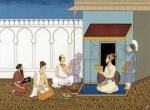Swami Vivekananda (1863-1902) was a widely-travelled person. For someone who had not even seen the age of forty, to have travelled so widely in India and other parts of the world was not altogether a chance happening. It was part of the task he was destined to carry out. On the one hand, he was representing in his embodied person the message of our ancient land wherever he went; on the other hand, he was a keen observer with deep insights into the general tendencies and nature of peoples and the broad workings of societies. Based on his travels in Europe in the late 1890’s and early 1900’s, he had already predicted the imminent war, and he had also predicted the rise of Russia or China as countries representing the masses. And these were not political or geo-strategic predictions! They originated in his deep understanding of the laws of nature and especially those of human nature.
What is probably less-known is that Vivekananda had also visited cities in Asia on his way from India to Chicago for the World Parliament of Religions. His remarks on Chinese and Japanese societies on the basis of his own observation are incisive. These observations are recorded in a letter he wrote to his Madras disciples and friends from Yokohama on 10 July 1893. This essay will discuss some of the Swami’s ideas about China and Japan.
On 31 May 1893, he set sail from Bombay on the S. S. ‘Peninsular’ (an event memorialised by his statue at the Gateway of India). The ship first reached Colombo, where the Swami got off to see the city. The next halt was at Penang on the Malaya Peninsula. On his way from Penang to Singapore, he had glimpses of Sumatra. He then described Singapore in some detail.
The next stop was Hong Kong. And he remarked: “You feel that you have reached China, the Chinese element predominates so much. All labour, all trade seems to be in their hands. And Hong Kong is real China.”1 Vivekananda then describes the lifestyle of the boatmen who carried passengers from the ship to the land. “These boats with two helms are rather peculiar. The boatman lives in the boat with his family. Almost always, the wife is at the helms, managing one with her hands and the other with one of her feet. And in ninety percent of cases, you find a baby tied to her back, with the hands and feet of the little Chin left free. It is a quaint sight to see the little John Chinaman dangling very quietly from his mother’s back, whilst she is now settling with might and main, now pushing heavy loads, or jumping with wonderful agility from boat to boat.”2 This sketch would convey without fail to any reader how hardy the Chinese commoner is. And Vivekananda brings out this aspect all too well in his next few sentences: “The Chinese child is quite a philosopher and calmly goes to work at an age when your Indian boy can hardly crawl on all fours. He has learnt the philosophy of necessity too well. Their extreme poverty is one of the causes why the Chinese and the Indians have remained in a state of mummified civilisation. To an ordinary Hindu or Chinese, everyday necessity is too hideous to allow him to think of anything else.”3 Of course, India and China had produced great civilizations in ancient times, but, as Vivekananda was quick to grasp, extreme poverty had put a halt on the civilizational progress, because, for the vast majority of the people, everyday concerns of finding one square meal a day far outweighed all other concerns.
In the context of his visit to China, it is not difficult to understand why Vivekananda had remarked later in 1896 that the “next upheaval” would come either from Russia or from China. He admitted he could not say with certitude from which one though. This was with reference to the rise of the masses after the historical period of the rise of the merchants (colonialism). We know today that both Russia and China experienced the rise of the masses under Communist regimes. We can say that in India too, we are experiencing a kind of mass upheaval in the form of Dalit assertion and assertion of the rights of several economically backward groups. In Vivekananda’s understanding, this is a historical necessity before we can again think of things high and sublime and attain cultural, intellectual and spiritual progress.
Vivekananda stayed in Hong Kong for three days. He described it as a beautiful town. He went to see Canton, which he described at some length. He also saw several Chinese temples in Canton. He then returned to Hong Kong and set sail for Japan. He landed at Nagasaki and recorded: “The Japanese are one of the cleanliest people on earth. Everything is neat and tidy. Their streets are nearly all broad, straight, and regularly paved…The short-statured, fair-skinned, quaintly-dressed Japs, their movements, attitudes, gestures, everything is picturesque. Japan is the land of the picturesque!” 4 Subsequently, he reached Kobe and from there took the land route to Yokohama with the idea of seeing the interior of Japan. He saw three big cities: the great manufacturing town Osaka, the former capital Kyoto and the present capital Tokyo. He remarked that the Japanese had fully awakened to the necessity of the times and organised their army and were increasing their navy. He observed that the Japanese were bent upon making everything in their own country. The Swami’s observations on culture may come as a delight to Indians: “I saw quite a lot of temples. In every temple there are some Sanskrit Mantras written in Old Bengali characters. Only a few of the priests know Sanskrit. But they are an intelligent sect…to the Japanese, India is still the dreamland of everything high and good.”5
Incidentally, Indian civilissation played a very significant role in pre-modern Japanese culture to the extent that there was a “systematic self-identification of Japan with India”6. And this was despite very little actual contact between the two lands. As Fabio Rambelli notes: “Until the nineteenth century, the Japanese Buddhists envisioned a world system in which India was the centre, China was located at the periphery…At least until the seventeenth century, many Japanese intellectuals envisioned their country and its culture in relation not only to China, but also and especially to India or Tenjiku…, as it was commonly known…”7
However, what is most noteworthy is Vivekananda’s remark when he finished describing these countries to his disciples: “…I want that numbers of our young men should pay a visit to Japan and China every year.”8Why? Certainly, he was not referring to any geo-strategic advantage that India could have reaped from this connection at that point of time. He was also not explicitly arguing for the doctrine of Pan-Asianism that was to develop later, especially in the wake of Rabindranath Tagore’s visit to China and Japan in the twentieth century. It was too early for this doctrine to be formulated. Let us not forget the Indian situation in late nineteenth century. It was precisely the condition of Indian society riven by caste oppression and unspeakable poverty that moved Vivekananda to undertake the journey to Chicago that also moved him to utter these words of appreciation for the struggling Chinese and Japanese. For him, China and Japan could provide some practical demonstration to the sinking Indian race of what striving for collective betterment can yield. These were after all Asian civilisations, not high on European materialism, with some regard for spiritual culture, yet not given to divisive superstitions, and at the same time, extremely hard-working and even meticulous, promptly devoted to action. Thus he remarked: “Come, see these people…Come, be men! Come out of your narrow holes and have a look abroad. See how nations are on the march! Do you love man? Do you love your country? Then come, let us struggle for higher and better things…India wants the sacrifice of at least a thousand of her young men—men, mind, and not brutes.”9
References:
1. Swami Vivekananda to Alasinga, Balaji, G.G., Banking Corporation and Madras Friends, 10 July 1893, in Letters of Swami Vivekananda, Advaita Ashrama, Kolkata, 2013, p. 34.
2. Ibid., p. 34.
3. Ibid., pp. 34-35.
4. Ibid., p. 36.
5. Ibid., pp. 36-37.
6. Fabio Rambelli, ‘The Idea of India (Tenjiku) in Pre-Modern Japan: Issues of Signification and Representation in the Buddhist Translation of Cultures’ in Tansen Sen, ed., Buddhism Across Asia: Networks of Material, Intellectual and Cultural Exchange, vol. 1, ISEAS & Manohar, Singapore & New Delhi, 2014, p. 261.
7. Ibid., p. 259.
8. Letters of Swami Vivekananda,p. 37.
9. Ibid., p. 37.
(Views expressed are of the author and do not necessarily reflect the views of the VIF)










Post new comment